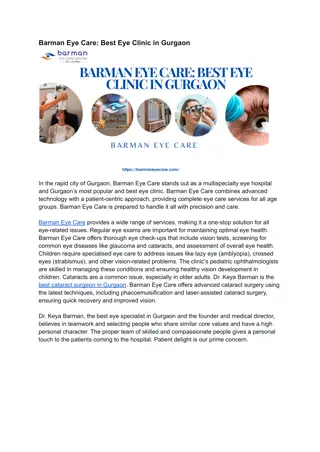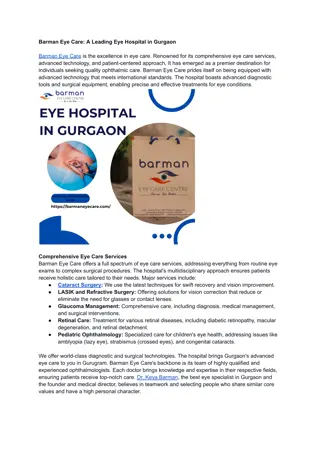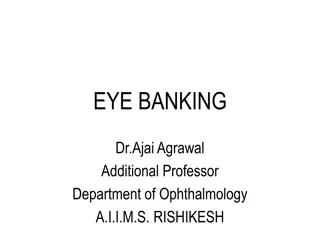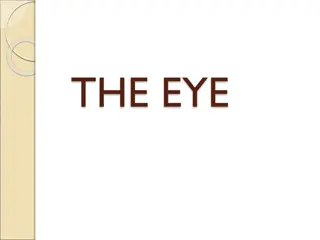Understanding Eye Anatomy and Surgical Procedures
Explore the detailed anatomy of the eye and its structures like the eyeball, optic nerve, conjunctiva, and lacrimal gland. Learn about common eye surgeries such as evisceration, enucleation, and exenteration. Discover the reasons for eye removal and the intricate procedures involved with insightful visuals.
Download Presentation

Please find below an Image/Link to download the presentation.
The content on the website is provided AS IS for your information and personal use only. It may not be sold, licensed, or shared on other websites without obtaining consent from the author. Download presentation by click this link. If you encounter any issues during the download, it is possible that the publisher has removed the file from their server.
E N D
Presentation Transcript
Eye and Ocular Adnexa Lamon Willis
Anatomy Eyeball an inch (25mm) in diameter Sclera white of the eye Cornea transparent Anterior chamber Pupil and Iris Choroid vascular layer Retina pigmented nerve layer
Anatomy Optic nerve and Optic disc Iris regulates light entering Pupil Vitreous humor fills posterior segment Ciliary body suspensory ligaments of lens Lens changes shape
Anatomy Conjunctiva pink eye cul-de-sac Muscles external
Anatomy Lacrimal gland Glaucoma intraocular pressure Refraction 20/20
Anatomy External ear tragus auricle or pinna Middle ear Tympanic membrane Ossicles malleus, incus, stapes Eustachian tube Oval window
Anatomy Inner ear Labyrinth Membranous labyrinth hair cells Vibrations into nerve impulse Cochlea, Vestibule, Semicircular canal Balance utricle, saccule Oval window, round window
CPT Procedures An eye typically is removed for one of three reasons: 1. the eye has a malignancy; 2. the eye is blind and very painful, or 3. the eye is blind and disfiguring.
CPT Procedures There are three types of removals (65091 65114): 1. Evisceration The contents of the eyeball are scooped out but the sclera shell remains connected to the eye muscles, so the prosthesis, fitted into the globe, will have natural movement. 2. Enucleation The connections (muscles, vessels, and optic nerve) are severed and the entire eyeball is removed en mass.
CPT Procedures 3. Exenteration Surrounding skin, fat, muscle and bone is removed. In any removal, a temporary implant may be placed to protect the void that may later hold a permanent implant. This temporary implant is included in the procedure and not reported separately. The implant codes reference permanent implants with aesthetic properties.
CPT Procedures Today, whenever a laser can be used to surgically cauterize, cut, destroy, or repair the eye, it will be used instead of a knife. When you are reviewing the codes in CPT s Eye and Ocular Adnexa section, assume any procedure with a laser approach is preferred to an open approach.
CPT Procedures Some surgeries require incisions. Removal of a lens with a cataract requires an incision, so the lens can be extracted and an IOL inserted. Even so, cataract surgery is done microscopically today, and tiny incisions in the limbus are all that is required.
CPT Procedures Injections are sometimes required to numb the eye. A retrobulbar or Tenon s capsule injection are two common approaches for delivery of anesthetic. These nerve blocks are bundled into the procedures and not reported separately.
CPT Procedures The majority of procedures performed on the anterior segment of the eye are microsurgeries performed using an operating microscope. The scope, otherwise reported with 69990, would not be reported separately.
CPT Procedures Surgeries on the iris and trabecular meshwork, including goniotomy, are usually a therapeutic treatment for glaucoma to improve the flow of aqueous in the eye. Sometimes aqueous is removed for therapy in paracentesis. This procedure also can be performed diagnostically.
CPT Procedures There are many procedures performed on the ocular adnexa. The extraocular muscles may be lengthened or shortened. In some cases, the procedure is not completed until the patient is awakened and lengthy sutures extruding from the back of the eye adjusted to ensure perfect binocular vision. These adjustable sutures are reported with add-on code +67335.
CPT Procedures The eyelids and conjunctiva are included in the adnexal codes. In prosthetics following evisceration, the conjunctiva may traverse an artificial cornea. When conjunctiva is damaged, buccal mucosa may be harvested and used as a graft (68325).
CPT Procedures Procedures to remove excess skin from the eyelid (blepharoplasty) are found in the integumentary chapter. Blepharoplasty codes in the Eye and Adnexa section involve more complex structures within the eye.























